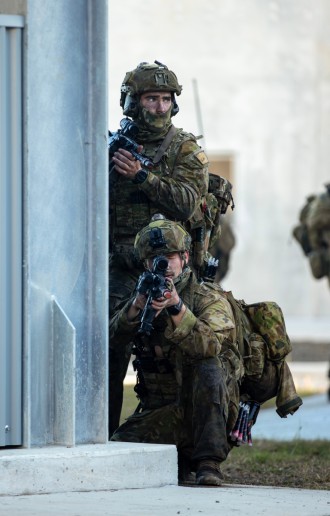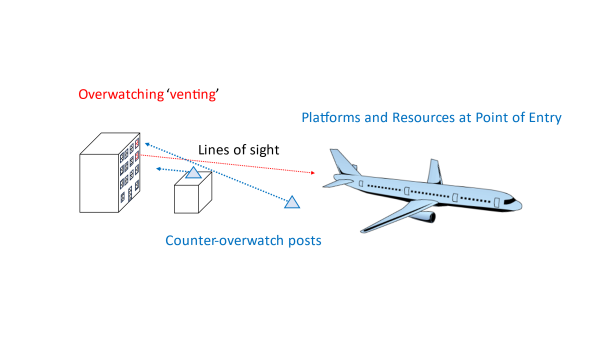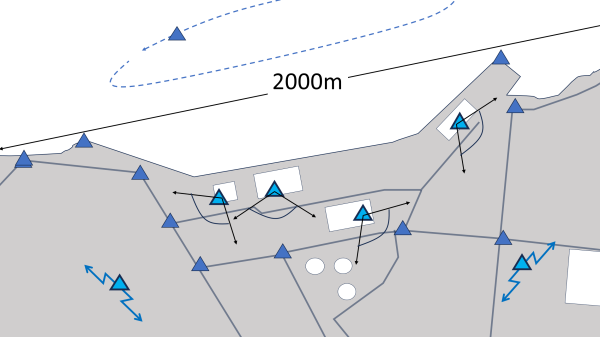The Question of Urban Perimeter Observation Post Numbers
Context
Gaining and retaining a secure Air or Sea Point of Entry (APOE/SPOE) is a critical Army enabling function for the Integrated Force to execute ‘anti-access/area denial’ (A2/AD) in the littoral as directed by the Defence Strategic Review (DSR). As explained by Dayton McCarthy in part two of this LPF series on littoral manoeuvre, projecting A2/AD systems and their logistics will almost invariably use a POE among urban terrain,. Securing an urban POE with current capabilities is likely to require a much larger securing force than we have seen exercised in rural ‘over-the-beach’ littoral conditions. This is first because of the complications that urban structures impose, which is then compounded by the complexities imposed by population. The important issue of population attitudes is explored in the next article in this series, but this post sets out to explain why a conventional POE security operation needs significantly greater numbers on urban terrain. It thereby highlights the value of capabilities that reduce the force requirement. In the discussion below, the focus is on troop numbers required for defensive ‘retaining’ rather than offensive ‘gaining’, as the former number can be more easily estimated. The issues are perimeter requirements, the personnel demand of the third dimension, counter overwatch and venting, as well as clearing and overwatch risk
Generic Perimeter Requirements
The scope of the task of securing a POE will vary with the terrain and the tactical situation, but in most cases the minimum requirement is to establish a perimeter of observation and response at small arms range. In order to occupy sufficient individual security Observation Posts (OP), this task may require surprisingly high numbers of troops, especially where Rules of Engagement are restrictive. This requirement can be represented graphically, as shown at Figure 1. A conventional approach, with current surveillance and night observation equipment, might involve deploying a series of intervisible OP at 500 m intervals. If we consider a ‘simplest case’ (where a force is simply securing an area 500m from an APOE with a 2.5 km runway) then, as shown in the left-side of the Figure, even on open terrain, maintaining a perimeter would need at least 16 separate elements (indicated by the blue triangles). On urban terrain it would be very unusual to be able to find 500 m lines of sight, so a larger number of more closely spaced positions would be needed to provide both a continuous perimeter of observation and checkpoints on each approach route. Bringing a perimeter closer-in typically does not significantly reduce the total requirement.
A comparable approach to secure a SPOE with a dock area 2 km long might see OPs placed at intervisible points several hundred metres apart along the road network. To achieve this would likely require a similar minimum number of OP to an APOE. In the urban littoral it may often also be necessary to secure water approaches, which may vary from open expanses of water to narrow drainage channels. To secure such terrain may require the positioning of further OPs to observe it as well as patrols with watercraft able to respond to detections. In both cases, a reasonable planning estimate for securing a perimeter with conventional capabilities (where there are few dominant buildings) is about 20 OP. This suggests that if section-sized OP are deployed, an infantry battalion-sized unit is probably a minimum basis for a POE tasked BG.
The Figure above represents a very basic approach in a situation where a perimeter of OPs is established at small arms range or along positions linked by of line of sight well forward of the runways or dock areas to be protected. In practice, especially where the deployed OPs are small to maximise coverage, it is likely to be necessary to have some other elements that can respond to suspected intrusions. Furthermore, it may also be necessary to secure/dominate an area extending far further away from where ships are moored or aircraft are parked. This is because of the need to prevent adversaries using surface-to-air missiles to attack aircraft landing or taking off, or employing stand-off weapons to strike targets in the POE. In this case, the additional OP that may be required to counter a portable surface-to-air (SAM) missile threat are illustrated by the further blue triangles shown at Figure 2 below. These are indicative minimum OP deployments several kilometres from runway thresholds for protecting military aircraft taking countermeasures. The ground engagement envelope for SAM against civil aircraft can be up to 10km x 80km[i].
Forward deployment of additional OP may be necessary to address threats other than SAM. For example, during the 1963-76 Dhofar War, rebels launched 122mm artillery rockets at RAF Base Salalah, Oman, from many kilometres away on the local crest of the overlooking mountain range. In response, the defending Sultan’s Armed Forces had to establish a series of defended OP and deploy sound ranging equipment there to deny these firing positions[ii]. In some cases, the personnel bill for achieving adequate security may be huge. During the ‘Defence of Australia’ Kangaroo series exercises in the 1990s, the task of securing RAAF Tindal was allocated to an infantry Brigade.
Various approaches may be used to maintain security with smaller numbers of personnel, including substantial fences and barriers, placing a greater reliance on sensors to detect intrusions, use of indirect fire to engage those intrusions and mobile reaction forces, often in armoured fighting vehicles that can rapidly redeploy to decisively engage identified enemy. A prime example of this approach is the RAF Regiment light armour squadrons that defended British airbases in West Germany during the Cold War. They were mounted in Scorpion and Spartan armoured vehicles and dispersed in small groups on the approaches. If the seismic or microwave sensor arrays detected a potential enemy intrusion, they were able to respond quickly with decisive firepower. However, the structures and populations of urban areas will preclude many such tactical efficiencies and time will preclude constructing extensive barriers.
The Personnel Demand of the Third Dimension
Where the area to be secured includes urban terrain, the threat from direct fire weapons or observers in populated areas becomes a fundamental issue. Where buildings overwatch aircraft on the ground or ships unloading, there may be a significant vulnerability to be addressed. The mobile response or firepower-based approaches described above are generally only sufficient on open terrain. Urban security, even when only considering two dimensions at surface level, may simply require more OP. As described above, this is because lines of sight within an urban littoral area will often be short, dictating that OP will need to be closer together to achieve a continuous perimeter. The challenge is exacerbated by the third dimension, and especially the problem of overwatching buildings.
Counter-Overwatch and Venting
Venting is the term to describe windows, doors and other apertures in a building through which observation may occur. Often there will be venting in upper levels of buildings that overwatch the area to be secured, yet this venting will not be visible from perimeter OP arranged at street level. The disposition of OP required to counter the threat of over-watch is illustrated in Figure 3. The aircraft on the right of the Figure represents vulnerable resources at a POE and the upper venting of the building on the left has a line of sight (dotted red line) to the aircraft. The post at ground level has its line of sight towards that threat venting blocked by an intermediate building. To mitigate this overwatch effect, a post has been deployed on that intermediate building.
The requirement to both maintain a perimeter and counter overwatch may further increase the personnel bill. Figure 4 represents a built-up urban area adjacent to a dock. The ‘perimeter OP’ (shown as blue triangles) have line of sight to each other along roads or tracks. Behind them in elevated positions (shown as paler blue triangles with arcs) are counter-overwatch OP, while there are screen OP deployed forward. Note that the arrangement of various OP shown is that required to maintain an unbroken perimeter, counter overwatch and screen. It does not consider any need for individual OP to be able to defend themselves against attack (rather than infiltration) which may require bigger groupings to achieve local all-round defence and depth.
The value of these Figures is to show that a key constraining factor when securing a POE is the area of influence a single element can exert. If the range (and therefore area) of influence of a single element is increased (in terms of both detection and response) then the total number of elements required is reduced. This is equally true in the third dimension. The greater the capacity of elements to not just observe, but detect and classify actors, the fewer elements that will be required and the more effective they will be.
Clearing, Overwatch and OP Manning Levels Risk Acceptance.
A crucial assessment when planning a POE operation is the acceptable level of two key risks. The first is the degree of clearing assurance to be achieved during the initial actions to secure the POE area. The options could vary from a visual external check of all the buildings, through a selective focus on particular buildings, up a detailed interior search of every one. The latter would likely require numbers, time and the involvement of a significant number of local security forces. One possible approach is a swift initial surface search followed by slower and systematic checking once a perimeter is established. Counterintuitively, clearing may not dictate the numbers required for the operation, provided phasing is feasible: securing usually presents demand.
The second risk is the degree of visual overwatch of the point of entry that can be accepted. The options vary from evacuating all overwatching buildings, through providing physical or obscured screens, to observing and patrolling around the dominating buildings. If as discussed above the perimeter alone requires about 20 OP, countering overwatch will likely require significantly more. It follows that a further key planning decision is the minimum number of soldiers in individual OP, as self-evidently, smaller numbers allow a greater number. This question is further explored in part 4 of this LPF series on littoral operations.
Conclusion
This post has explored key urban POE planning considerations: perimeter requirements, the personnel demand of the third dimension, counter overwatch and venting, as well as clearing and overwatch risk acceptance. It has demonstrated that retaining an urban POE with a conventional approach employing section level OP may require upwards of an infantry battalion, which is a larger ground force than is currently assumed. Yet before the ‘troops to task’ bill can be estimated, the appropriate size of OP must be considered. This factor is explored in the next article of the series.
Complete Series:
Part Two: Army’s Role in the Strategy of Denial: Point of Entry Security in the Urban Littoral Environment
Part Three: The Question of Urban Perimeter Observation Post Numbers
Part Four: The Question of Urban Position Minimum Strength
Part Five: Enhancing Capability to Secure Urban Points of Entry
[i] Man-Portable Air Defence Systems (MANPADS): Countering the Terrorist Threat. 2008, DFAT/ASPI: Canberra.
[ii] Pimlott, J., British Army: The Dhofar War. Counter Insurgency: Lessons from History, 2011: p. 16.








